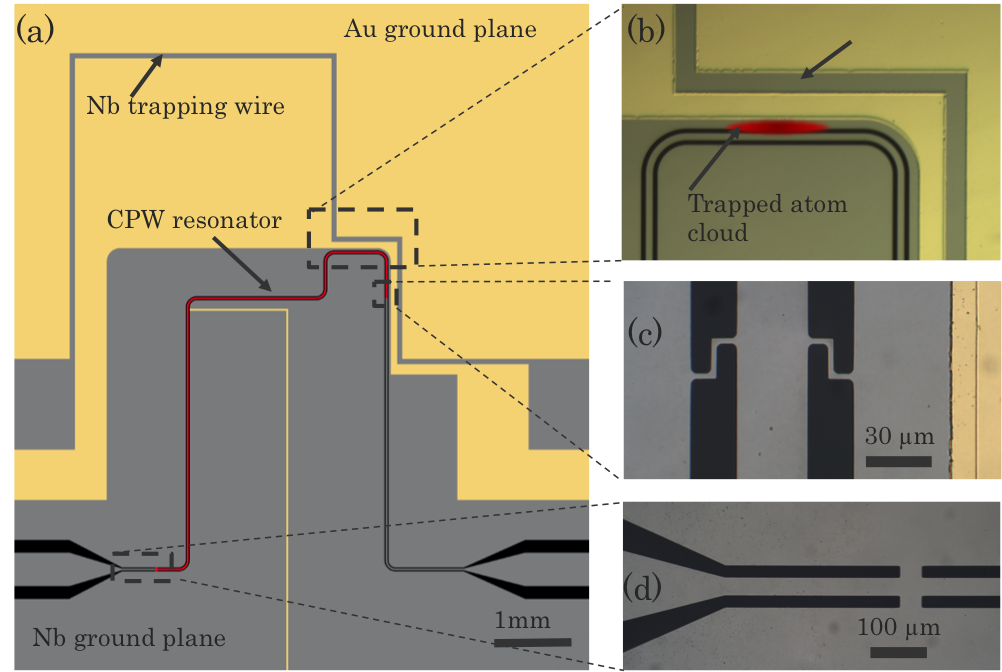News
21.12.2017
Quantum coupling
Tübingen University physicists are the first to link atoms and superconductors in key step towards new hardware for quantum computers and Networks.
Today’s quantum technologies are set to revolutionize information processing, communications, and sensor technology in the coming decades. The basic building blocks of future quantum processors are, for example, atoms, superconducting quantum electronic circuits, spin crystals in diamonds, and photons. In recent years it has become clear that none of these quantum building blocks is able to meet all the requirements such as receiving and storing quantum signals, processing and transmitting them. A research group headed by Professors József Fortágh, Reinhold Kleiner and Dieter Kölle of the University of Tübingen Institute of Physics has succeeded in linking magnetically-stored atoms on a chip with a superconducting microwave resonator. The linking of these two building blocks is a significant step towards the construction of a hybrid quantum system of atoms and superconductors which will enable the further development of quantum processors and quantum networks. The study has been published in the latest Nature Communications.
Quantum states allow especially efficient algorithms which far outstrip the conventional options to date. Quantum communications protocols enable, in principle, unhackable data exchange. Quantum sensors yield the most precise physical measurement data. “To apply these new technologies in everyday life, we have to develop fundamentally new hardware components,” Fortágh says. Instead of the conventional signals used in today’s technology – bits – which can only be a one or a zero, the new hardware will have to process far more complex quantum entangled states.
“We can only achieve full functionality via the combination of different quantum building blocks,” Fortágh explains. In this way, fast calculations can be made using superconducting circuits; however storage is only possible on very short time scales. Neutral atoms hovering over a chip’s surface, due to their low strength for interactions with their environment, are ideal for quantum storage, and as emitters of photons for signal transmission. For this reason, the researchers connected two components to make a hybrid in their latest study. The hybrid quantum system combines nature’s smallest quantum electronic building blocks – atoms – with artificial circuits – the superconducting microwave resonators. “We use the functionality and advantages of both components,” says the study’s lead author, Dr. Helge Hattermann, “The combination of the two unequal quantum systems could enable us to create a real quantum processor with superconducting quantum lattices, atomic quantum storage, and photonic qubits.” Qubits are – analogous to bits in conventional computing – the smallest unit of quantum signals.
The new hybrid system for future quantum processors and their networks forms a parallel with today’s technology, which is also a hybrid, as a look at your computer hardware shows: Calculations are made by microelectronic circuits; information is stored on magnetic media, and data is carried through fiber-optic cables via the internet. “Future quantum computers and their networks will operate on this analogy – requiring a hybrid approach and interdisciplinary research and development for full functionality,” Fortágh says.
Publication:
H. Hattermann, D. Bothner, L. Y. Ley, B. Ferdinand, D. Wiedmaier, L. Sárkány, R. Kleiner, D. Koelle, and J. Fortágh: Coupling ultracold atoms to a superconducting coplanar waveguide resonator. Nature Communications, DOI 10.1038/s41467-017-02439-7.
Contact:
Dr. Helge Hattermann
helge.hattermann[at]uni-tuebingen.de
Prof. Dr. József Fortágh
fortagh[at]uni-tuebingen.de
University of Tübingen
Faculty of Science
Institute of Physics
CQ Center for Quantum Science
Phone +49 7071 29-76270
http://www.physik.uni-tuebingen.de/fortagh
Eberhard Karls Universität Tübingen
Public Relations Department
Dr. Karl Guido Rijkhoek
Director

